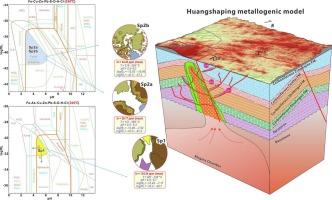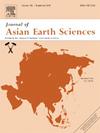华南黄坪矽卡岩Zn-Pb体系中铟富集条件的热力学模拟
IF 2.4
3区 地球科学
Q2 GEOSCIENCES, MULTIDISCIPLINARY
引用次数: 0
摘要
铟是一种关系到国家繁荣和国防的战略金属,对光电等新兴产业至关重要。然而,对夕卡岩型铅锌矿床在迁移-沉淀过程中的富集认识有限。本文以南岭带黄沙坪锌矿床为研究对象,研究了以石英斑岩为成矿侵入体的矽卡岩型铅锌矿床。岩石学鉴定成矿分为矽卡岩期、氧化期和硫化物期,形成3种闪锌矿类型(Sp1、Sp2a、Sp2b)。EPMA和LA-ICP-MS分析显示不同的铟浓度,其中Sp1富集最多(平均= 134.54 ppm)。LA-ICP-MS图谱显示Sp1富含in、Cu和Sn。矿物共生结合GGIMFis闪锌矿微量元素温度计和热力学计算表明,富铟闪锌矿在弱酸性pH 4.5-6.0、高氧逸度(logfO2 = -32.2至- 29.7)、高温(201-316℃)和高硫逸度(logfS2 = - 13.42至- 7.11)的还原富h2s环境下析出。我们认为,在矽卡岩体系中,铟的富集发生在闪锌矿结晶的早期阶段,特别是在高温下。这种富集过程发生在以弱酸性pH、高氧逸度和高硫逸度为特征的流体环境中。这一发现加深了我们对矽卡岩型铅锌体系中铟富集及其物化条件的认识,对同类矿床的找矿具有指导意义。本文章由计算机程序翻译,如有差异,请以英文原文为准。

Thermodynamic simulation on indium enrichment condition in the Huangshaping skarn Zn-Pb system (South China)
Indium, crucial for emerging industries like optoelectronics, is a strategic metal linked to national prosperity and defense. However, understanding its enrichment during migration-precipitation in skarn-type Zn-Pb deposits is limited. This study focuses on the Huangshaping Zn-Pb deposit in the Nanling belt, China, which is a skarn-type deposit with quartz porphyry as the ore-causative intrusion. Through petrography, mineralization was identified as skarn, oxide, and sulfide stages, with three sphalerite types (Sp1, Sp2a, Sp2b). EPMA and LA-ICP-MS analyses revealed different indium concentrations, with Sp1 being the most enriched (mean = 134.54 ppm). LA-ICP-MS mapping showed that Sp1 is rich in In, Cu, and Sn. Mineral paragenesis combined with GGIMFis thermometer for sphalerite trace elements and thermodynamic calculations indicate indium-rich sphalerite precipitates under weakly acidic pH 4.5–6.0, high oxygen fugacity (logfO2 = –32.2 to −29.7), high temperature (201–316 °C), and high sulfur fugacity (logfS2 = −13.42 to −7.11) in a reduced, H2S-rich environment. We propose that in skarn systems, the enrichment of indium occurs during the early stages of sphalerite crystallization, specifically at high temperatures. This enrichment process occurs in a fluid environment characterized by a weakly acidic pH, high oxygen fugacity, and high sulfur fugacity. The findings deepen our understanding on indium enrichment and the physicochemical conditions in skarn-type Zn-Pb systems and may aid prospecting in similar deposits.
求助全文
通过发布文献求助,成功后即可免费获取论文全文。
去求助
来源期刊

Journal of Asian Earth Sciences
地学-地球科学综合
CiteScore
5.90
自引率
10.00%
发文量
324
审稿时长
71 days
期刊介绍:
Journal of Asian Earth Sciences has an open access mirror journal Journal of Asian Earth Sciences: X, sharing the same aims and scope, editorial team, submission system and rigorous peer review.
The Journal of Asian Earth Sciences is an international interdisciplinary journal devoted to all aspects of research related to the solid Earth Sciences of Asia. The Journal publishes high quality, peer-reviewed scientific papers on the regional geology, tectonics, geochemistry and geophysics of Asia. It will be devoted primarily to research papers but short communications relating to new developments of broad interest, reviews and book reviews will also be included. Papers must have international appeal and should present work of more than local significance.
The scope includes deep processes of the Asian continent and its adjacent oceans; seismology and earthquakes; orogeny, magmatism, metamorphism and volcanism; growth, deformation and destruction of the Asian crust; crust-mantle interaction; evolution of life (early life, biostratigraphy, biogeography and mass-extinction); fluids, fluxes and reservoirs of mineral and energy resources; surface processes (weathering, erosion, transport and deposition of sediments) and resulting geomorphology; and the response of the Earth to global climate change as viewed within the Asian continent and surrounding oceans.
 求助内容:
求助内容: 应助结果提醒方式:
应助结果提醒方式:


